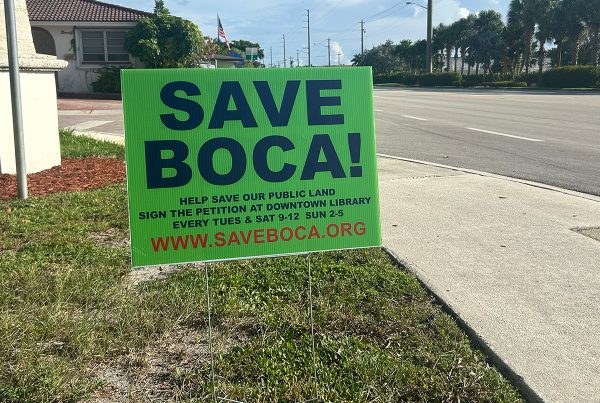Last week, the wave of opposition to Boca Raton’s proposed downtown redevelopment hit the city council meeting.
Dozens of residents spoke against the plan for the 30 acres around City Hall. The crowd overflowed into the lobby. Four and a half hours passed between the start of the staff presentation and the end of council members’ comments.
Some comments were personal and hostile. Vote for the Terra/Frisbie plan, one speaker told the council, “And you’ll never win another election in this city.” Mere consideration of the plan meant that the council is “corrupt.” One speaker threatened to start a recall petition against any council member who supports the plan. (Florida law does not allow recalls over policy differences.) Applause followed every comment.
Overall, though, the speakers—many wearing Save Boca! T-shirts—focused on a credible point: If the community is so opposed to the plan, why is the city pushing it so hard?
There’s no mistaking that opposition. Last week’s crowd was the largest, but at meetings over the last few months barely a handful of speakers have supported the plan. Almost 90 percent of comments on the city’s website have been critical. Of the other 10 percent, most did agree that Terra/Frisbie’s plan was the best of four the council considered.
Then there’s the Save Boca! petition that seeks to force a proxy referendum on the project. It would require a public vote on the sale or lease of one-half acre or more of city property.
Organizers claim to have 5,200 signatures toward a proposed charter change to that effect. Any realistic council member must assume that the petitioners will meet their goal, fattening a March ballot that already features a mayor’s race between council members Fran Nachlas and Andy Thomson.
Mayor Scott Singer repeatedly has suggested that there is significant, if not visible, support for the project. But he has offered no evidence. So, I asked. We spoke Tuesday.
Singer said he has had “conversations” with residents who like the council’s approach of partnering with a private developer. He has received “emails that may not be going to” the city’s comment site. “As more information comes out,” Singer said, “there will be more support.”
Councilman Marc Wigder echoed that thought. Because the city and Terra/Frisbie remain in the due diligence period after approval of the interim master plan, the public has heard “a one-sided story.” When more specifics emerge, “We can paint a complete picture.” The city “needs to keep our options open.”
Wigder plans to continue stressing his main point: Boca Raton will need money. Terra/Frisbie projects $3 billion to the city over those 99 years, though the city has not verified that amount. Wigder notes the push in Tallahassee to end or reduce property taxes. He notes that when the Community Redevelopment Agency expires in 2042, roughly $25 million that goes to the city will go to other government agencies.
Clearly, though, the council got way ahead of public opinion. There was no community outreach last fall—when the scope became apparent—of what redevelopment might entail. Terra/Frisbie proposes 912 apartments, 155,000 square feet of retail and restaurant space, 350,000 square feet of offices and a 150-room hotel.
As one resident posted in January, “I have received 20 messages regarding” the city’s centennial and one about the January meeting when the four bidders made their presentations.
Council members also don’t seem to have anticipated the resistance to eliminating recreational facilities in the area: the tennis center, two softball fields, the skate park, a playground and a basketball court. As a result, the staff has had to scramble.
Very quickly came plans for a softball complex at Sugar Sand Park and a skate park at North Park. Those constituencies, which turned out early, have not come back.
Tennis has been stickier. The city plans to build 10 clay courts at Meadows Park to replace the 10 at the tennis center. Debate continues, though, about whether to keep some public courts downtown.
And, to show how scrambling can backfire, neighbors of Meadows Park now object to the tennis expansion. Those 10 courts, plus a building for lockers and such, would displace the softball field at the north end of the site. The playground and beach volleyball court would move to the south end, next to the community garden that itself was moved to make way for the Brightline station.

Last week, Singer told residents that the council had made no final decision. “This is a process that’s unfolding,” Opponents clearly don’t believe him, pointing out that the council remains on track to vote next month on the final master plan, even though there remains no accounting of the public costs in this public-private partnership.
Wigder acknowledged that the schedule is “unrealistic” and must be “pushed back.” He lamented that gap between resident and council sentiment. Everyone on the council agrees that downtown redevelopment is necessary. “How do we do this together?”
Ironically, the council sought a private partner because an earlier review of what it would cost to build a new city hall and community center showed that the public cost would be prohibitive. That same public now doesn’t want private help. Wigder’s well-meaning sentiment seems several months late.
Downtown campus factoring into Boca mayor race
Redevelopment politics have become inseparable from the Boca Raton mayor race.
Last week, Thomson reminded the audience that he was the only council member to vote against the interim master plan. The city, he said, “doesn’t need to do a public-private partnership.” The October timetable is “unrealistic.” Referring to opponents who used “you all” when criticizing the council, Thomson said, “Not me.” Pushing ahead despite opposition has caused “an erosion of public trust” of the city.
Singer and Nachlas asked Thomson why he had voted to choose Related Ross over Terra/Frisbie when Related’s plan was more intense. Thomson responded, as he has before, that he wanted Related Ross as the partner and was not voting on the company’s plan.
Nachlas then asked why Thomson at that meeting voted to move ahead. Thomson didn’t respond then, but he told me Wednesday that it’s been “a tradition” on big issues for dissenting council members to “show solidarity.” He noted that he originally voted for James Zervis to succeed George Brown as city manager but then made it unanimous when his four colleagues preferred Mark Sohaney.
“Rather than be a stick in the mud at every turn,” Thomson said, he voted to “advance the discussion.” What he has seen from that discussion, Thomson said, he doesn’t like.
FAU invests heavily in athletic programs

In writing last month about what Florida Atlantic University calls its most academically talented first-year class, I should have noted that the Wilkes Honor College on the Jupiter campus has a record 193 students.
According to a news release, FAU also has a record 40 National Merit Scholars on campus. Nineteen are returning students, and 21 are in that freshman class.
I also wrote about the new financial world of college sports in which FAU is trying to compete. Not only can athletes receive compensation for use of their name, image and likeness (NIL), schools must share revenue with athletes, doled out by team and player as the school decides.
The American Athletic Conference to which FAU belongs set a minimum payment of $10 million, with Army and Navy excepted. That will increase over the next two years. For perspective, schools in the so-called Power 4, higher-rated football conferences can pay $20.5 million. FAU’s athletic budget for this year is $44.5 million—a 10 percent increase.
In this new system, football becomes even more important, because it finances most of the budget. The Owls opened their first season under Head Coach Zach Kittley with a 39-7 loss at Maryland. In its preseason rankings, The Athletic website placed the Owls 118th of 136 teams in the Football Bowl Subdivision, formerly known as Division I. FAU opens at home Saturday against Florida A&M.
A clarification on Boca’s plan to connect Federal Highway and Northwest Second Avenue
I also wrote recently about Boca Raton moving ahead with the plan to create a Florida East Coast Railway crossing at Jeffrey Street, just north of Yamato Road. Extending Jeffrey Street from Federal Highway to Northwest Second Avenue will create an east-west route across the northern part of the city.
I should have reminded readers that the plan also includes closing the crossing at 28th Street and Dixie Highway. Federal officials at first wanted Boca Raton to close three crossings to create the one at Jeffrey Street. The city negotiated the number down to just the one.
Boca double murder suspect makes a rare request

The man accused of murdering two people and trying to murder another last year in Boca Raton wants to have his attorney see the evidence against him—and only his attorney.
DeVante Moss filed his motion this week. Moss argues his “independent” examination is necessary to ensure “adequate investigation and preparation” of his defense. It must happen outside of the “prying eyes” of the assistant state attorney handling the case and the lead detective.
The issue is how much the prosecution must show Moss’s attorney during discovery. Moss argues that the evidence itself is “work product” rather than “opinion product”—the prosecution’s discussions of the case. As such, he says, it is not privileged and subject to discovery.
Moss wants the only outside participant to be the evidence custodian at the Palm Beach County Sheriff’s Office. He also wants no recording of his examination. His attorney cites 23 court rulings for defendants who filed similar requests. The state has not submitted its response.
Alleged Boca Bash strangler case continues

Meanwhile, the case of the man accused of strangling his girlfriend at Boca Bash in 2022 drags on.
At this week’s status hearing, the judge ordered a continuance until Dec. 22. Cole Preston Goldberg faces one count of attempted second-degree murder, one count of domestic battery by strangulation and one count of battery.
Boca Beach and Park District holds ribbon-cutting for North Park traffic garden
The Greater Boca Raton Beach and Park District holds a ribbon-cutting today for the traffic garden at North Park, formerly the Ocean Breeze Golf Course.
Built on what were dilapidated tennis courts, the traffic garden will allow children to learn bicycle safety in a car-free setting. According to a news release, the district has added bathrooms since the soft opening last month. Plans are to install a shaded setting area from which parents can monitor children. Parking is available.
This new feature is part of the district’s master plan for the property it bought seven years ago in the Boca Teeca community. The district just paid off the bonds seven years early. In June, work began on Boca Paddle, the racket facility. The city also plans to build the skate park that will replace the 26-year-old downtown facility.







